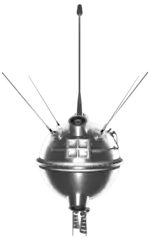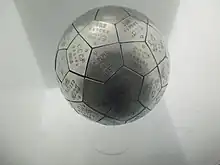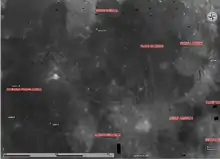 Model of Luna 2 | |
| Names | Second Soviet Cosmic Rocket Lunik 2 |
|---|---|
| Mission type | Lunar impactor |
| Operator | OKB-1 |
| Harvard designation | 1959 ξ 1[1] |
| COSPAR ID | 1959-014A[2] |
| SATCAT no. | 00114[3] |
| Mission duration | 2 days, 14 hours, 22 minutes, 41 seconds[4][lower-alpha 1] |
| Spacecraft properties | |
| Manufacturer | OKB-1[1] |
| Launch mass | 390.2 kg[5] |
| Start of mission | |
| Launch date | 12 September 1959 06:39:42 GMT[4][lower-alpha 1] |
| Rocket | Luna 8K72 s/n I1-7B[6] |
| Launch site | Baikonur, Site 1/5[7] |
| Contractor | OKB-1 |
| Orbital parameters | |
| Epoch | 12 September 1959 |
| Lunar impactor | |
| Impact date | 13 September 1959 21:02:24 GMT[4][lower-alpha 1] |
| Impact site | 29°06′N 0°00′E / 29.1°N -0°E |
Luna 2 (Russian: Луна 2), originally named the Second Soviet Cosmic Rocket and nicknamed Lunik 2 in contemporaneous media, was the sixth of the Soviet Union's Luna programme spacecraft launched to the Moon, E-1 No.7. It was the first spacecraft to reach the surface of the Moon, and the first human-made object to make contact with another celestial body.
The spacecraft was launched on 12 September 1959 by the Luna 8K72 s/n I1-7B rocket. It followed a direct path to the Moon. In addition to the radio transmitters sending telemetry information back to Earth, the spacecraft released a sodium gas cloud so the spacecraft's movement could be visually observed. On 13 September 1959, it impacted the Moon's surface east of Mare Imbrium near the craters Aristides, Archimedes, and Autolycus.
Prior to impact, two sphere-shaped pennants with USSR and the launch date engraved in Cyrillic were detonated, sending pentagonal shields in all directions. Luna 2 did not detect radiation or magnetic belts around the Moon.
Background
Luna 1 and the three spacecraft of Luna programme before it were part of the Ye-1 series of spacecraft with a mass of 156 kilograms (344 lb).[8] Luna missions that failed to successfully launch or achieve good results remained unnamed and were not publicly acknowledged.[9][10] The first unnamed probe exploded on launch on 23 September 1958. Two more launches were unsuccessfully attempted on 11 October 1958 and 4 December 1958.[11] Luna 1 was the fourth launch attempt and the first partial success of the program.[12] It launched on 2 January 1959 and missed the Moon by 5,965 kilometres (3,706 mi).[13]
One mission separated Luna 1 and Luna 2, a launch failure that occurred with an unnamed probe on 18 June 1959.[14] Luna 2 would be the Soviet Union's sixth attempt to impact the Moon.[15] It was the second of the Ye-1a series, modified to carry a heavier payload of 156 kilograms (344 lb)[16] and had a combined mass of 390.2 kilograms (860 lb).[17] Luna 2 was similar in design to Luna 1,[18] a spherical space probe with protruding antennas and instrumentation.[19] The instrumentation was also similar to Luna 1,[18] which included a triaxial fluxgate magnetometer,[20] a piezoelectric detector, a scintillation counter, ion traps and two gas-discharge counters, while the Luna 2 included six gas-discharge counters.[21] There were no propulsion systems on Luna 2 itself.[22]
Payload

Luna 2 carried five different types of instruments to conduct various tests while it was on its way to the Moon.[23] The scintillation counters were used to measure any ionizing radiation and the Cherenkov radiation detectors to measure electromagnetic radiation caused by charged particles.[24] The primary scientific purpose of the Geiger Counter carried on Luna 2 was to determine the electron spectrum of the Van Allen radiation belt. It consisted of three STS-5 gas-discharge counters mounted on the outside of an airtight container.[25] The last instrument on Luna 2 was a three component fluxgate magnetometer. It was similar to that used on Luna 1 but its dynamic range was reduced by a factor of 4 to ±750 gammas (nT) so that the quantisation uncertainty was ±12 gammas.[26] The probe's instrumentation was powered by silver-zinc and mercury-oxide batteries.[24][27]

The spacecraft also carried Soviet pennants which were located on the probe and on the Luna 2 rocket.[28] The two sphere-shaped pennants in the probe had surfaces covered by 72 pentagonal elements in a pattern similar to that later used by association footballs.[29][30] In the centre was an explosive charge designed to shatter the sphere, sending the pentagonal shields in all directions.[30] Each pentagonal element was made of titanium alloy; the centre regular pentagon had the State Emblem of the Soviet Union with the Cyrillic letters СССР ("USSR") engraved below and was surrounded by five non-regular pentagons which were each engraved with СССР СЕНТЯБРЬ 1959 ("USSR SEPTEMBER 1959").[29][31] The third pennant was similar engravings on aluminium strips which were embossed on the last stage of the Luna 2 rocket.[28]
The scientists took extra, unspecified precautions in preventing biological contamination of the Moon.[32]
Mission
Launch and trajectory
A launch was first attempted on 9 September 1959, but the first stage engines failed to reach full thrust, and the launch was aborted while the rocket was on the launch pad.[33] The second attempt occurred on 12 September 1959, and Luna 2 lifted off at 06:39:42 GMT.[7][lower-alpha 1]
Once the vehicle reached Earth's escape velocity, the upper stage was detached, allowing the probe to travel on its path to the Moon. Luna 2 pirouetted slowly, making a full rotation every 14 minutes, while sending radio signals at 183.6, 19.993 and 39.986 MHz.[33] The probe started transmitting information back to Earth using three different transmitters. These transmitters provided precise information on its course, allowing scientists to calculate that Luna 2 would hit its mark on the Moon around 00:05 on 14 September (Moscow Time), which was announced on Radio Moscow.[33]
Because of claims that information received from Luna 1 was fake, the Russian scientists sent a telex to astronomer Bernard Lovell at Jodrell Bank Observatory at the University of Manchester. Having received the intended time of impact, and the transmission and trajectory details, it was Bernard Lovell who confirmed the mission's success to outside observers. However, the American media were still skeptical of the data until Lovell was able to prove that the radio signal was coming from Luna 2 by showing the Doppler shift from its transmissions.[34][35]
Lunar impact

Luna 2 took a direct path to the Moon,[36] starting with an initial velocity from Earth of 11.2 kilometres per second (25,000 mph)[33] and impacting on the Moon at about 3.3 kilometres per second (7,400 mph).[37] It hit the Moon about 0° West and 29.1° North of the centre of the visible disk at 00:02:24 (Moscow Time) on 14 September 1959.[17][38][lower-alpha 1] The probe became the first human-made object to hit another celestial body.[39] To be able to provide a visual from Earth on 13 September, the Luna 2 released a vapour cloud that expanded to a 650 kilometres (400 mi) diameter and was seen by observatories in Alma Ata, Byurakan, Abastumani, Tbilisi, and Stalinabad.[33] This vapour cloud also acted as an experiment to see how the sodium gas would act in a vacuum and zero gravity.[22] The last stage of the rocket that carried Luna 2 also hit the Moon's surface about 30 minutes after Luna 2, but there was uncertainty as to where it landed.[22]
Bernard Lovell began tracking the probe about five hours before it impacted the Moon and also recorded the transmission from the probe, which ends abruptly. He played the recording during a phone call to reporters in New York to finally convince most media observers of the mission's authenticity.[38]
Results
The radiation detectors and magnetometer were searching for lunar magnetic and radiation fields similar to the Van Allen radiation belt around Earth, sending information about once every minute[26] until its last transmission which came about 55 kilometres (34 mi) away from the lunar surface.[40] Although it did prove previous measurements of the Van Allen radiation belts that were taken from Luna 1 around the Earth,[40] it was not able to detect any type of radiation belts around the Moon[41] at or beyond the limits of its magnetometer's sensitivity (2–3x10−4 G).[42]
Luna 2 showed time variations in the electron flux and energy spectrum in the Van Allen radiation belt.[43] Using ion traps on board, the satellite made the first direct measurement of solar wind flux from outside the Earth's magnetosphere.[44] On its approach to the lunar surface, the probe did not detect any notable magnetic field to within 55 kilometres (34 mi) from the Moon.[23][40] It also did not detect a radiation belt around the Moon, but the four ion traps measured an increase in the ion particle flux at an altitude of 8,000 kilometres (5,000 mi), which suggested the presence of an ionosphere. The probe generated scientific data that was printed on 14 kilometres (8.7 mi) of teletype, which were analysed and published in spring 1960.[41]
Cultural significance
According to Donald William Cox, Americans were starting to believe that they were making progress in the Space Race and that although the Soviet Union might have had larger rockets, the United States had better guidance systems, but these beliefs were questioned when the Soviets were able to impact Luna 2 on the Moon.[45][46] At that time the closest Americans had come to the Moon was about 60,000 kilometres (37,000 mi) with Pioneer 4.[46] Soviet Premier Nikita Khrushchev, on his only visit to the United States, gave President Dwight D. Eisenhower a replica of the Soviet pennants that Luna 2 had just placed onto the lunar surface.[46][47]
Legacy
Luna 2 was a success for the Soviets, and was the first in a series of missions (lunar impactors) that were intentionally crashed on the Moon. The later U.S.-made Ranger missions ended in similar impacts. Such controlled crashes have remained useful even after the technique of soft landing was mastered.[48] NASA used hard spacecraft impacts to test whether shadowed Moon craters contain ice by analyzing the debris that got thrown out.[49]
The pennant presented to Eisenhower is kept at the Eisenhower Presidential Library and Museum in Abilene, Kansas, U.S.[50] A copy of the spherical pennant is located at the Kansas Cosmosphere in Hutchinson, Kansas.[51]
On 1 November 1959, the Soviet Union released two stamps commemorating the spacecraft. They depict the trajectory of the mission.[52]
See also
References
Notes
Citations
- 1 2 Krebs, Gunter. "Luna Ye-1A". Gunter's Space Page. Retrieved 10 July 2019.
- ↑ "Luna 2 Launch and Trajectory Information". NASA Space Science Data Coordinated Archive. Retrieved 28 March 2019.
- ↑ "Luna 2". N2YO.com. Retrieved 10 July 2019.
- 1 2 3 Siddiqi, Asif A. (2018). Beyond Earth: A Chronicle of Deep Space Exploration, 1958–2016 (PDF). NASA.
- ↑ "Luna 2". NASA Space Science Data Coordinated Archive. Retrieved 9 January 2023.
- ↑ Lardier & Barensky 2013, p. 406.
- 1 2 "Luna 02". NASA Science Solar System Exploration. Archived from the original on 26 April 2020. Retrieved 8 July 2019.
Luna 2 (as it was renamed in 1963)...
- ↑ Harvey 2007, pp. 22, 30.
- ↑ Harvey 2007, p. 24.
- ↑ Lund 2018, p. 333.
- ↑ Harvey 2007, pp. 22–24.
- ↑ Zak, Anatoly (2 January 2019). "Luna-1: USSR launches the first artificial planet". Russian Space Web. Retrieved 16 March 2019.
- ↑ Harvey 2007, pp. 25, 27.
- ↑ Harvey 2007, pp. 30–31.
- ↑ Zak, Anatoly (16 October 2013) [Updated 16 September 2018]. "Moon Missions". Russian Space Web. Retrieved 16 March 2019.
- ↑ Harvey 2007, p. 30.
- 1 2 Moore & Rees 2014, p. 40.
- 1 2 Christy, Robert. "The Mission of Luna 2". Zarya.info. Retrieved 17 March 2019.
- ↑ Koren, Marina (3 January 2019). "Why the Far Side of the Moon Matters So Much". The Atlantic. Retrieved 16 March 2019.
- ↑ Williams, David R. (ed.). "NSSDCA – Experiment – Details: 1959-014A-01". NASA Space and Science Data Coordinated Archive. Retrieved 8 July 2019.
- ↑ Siddiqi 2002, pp. 21, 23.
- 1 2 3 "Luna 2". NASA Space Science Data Coordinated Archive. Retrieved 12 March 2019.
- 1 2 Siddiqi 2002, p. 23.
- 1 2 Huntress & Marov 2011, p. 73.
- ↑ "Geiger Counter". NASA Space Science Data Coordinated Archive. Retrieved 12 March 2019.
- 1 2 "Triaxial Fluxgate Magnetometer". NASA Space Science Data Coordinated Archive. Retrieved 12 March 2019.
- ↑ Mitchell, Don P. "Lunar Impact capsule". Mental Landscape LLC. Retrieved 20 March 2019.
- 1 2 Capelotti 2014, p. 44.
- 1 2 Cavallaro 2018, p. 48.
- 1 2 Waldstein & Turoma 2016, p. 262.
- ↑ Kovalev, Alexander (14 September 2009). "СССР полвека назад впервые в истории осуществил успешный полет на Луну" [Half a century ago, for the first time in history, the USSR carried out a successful flight to the moon]. RIA Novosti (in Russian). Retrieved 1 July 2019.
- ↑ Frankel, Max (14 September 1959). "Soviet Rocket Hits Moon After 35 Hours; Arrival Is Calculated Within 84 Seconds; Signals Received Till Moment of Impact". The New York Times. p. 1.
- 1 2 3 4 5 Harvey 2007, p. 31.
- ↑ Harvey 2007, pp. 32–33.
- ↑ Lovell 1959, p. 54.
- ↑ Reeves 2013, p. 39.
- ↑ Corda 2017, p. 47.
- 1 2 Harvey 2007, p. 33.
- ↑ "Missions to the Moon". The Planetary Society. Retrieved 12 March 2019.
- 1 2 3 Harvey 2007, p. 32.
- 1 2 Harvey 2007, p. 34.
- ↑ Significant Achievements in Planetology 1958–1964. Washington D.C.: NASA. 1966. p. 43. OCLC 30740240.
- ↑ Hendrickx 2010, p. 128.
- ↑ Ogurtsov et al. 2015, p. 35.
- ↑ Cox 1962, pp. 47, 118.
- 1 2 3 Cavendish, Richard (2009). "The Soviet Union is first to the Moon". History Today. Vol. 59, no. 9.
- ↑ Daniloff 1972, p. 105.
- ↑ Phillips, Tony (28 July 2006). "Crash Landing on the Moon". Science@NASA. Retrieved 20 April 2016.
- ↑ Hoover, Rachel; Jones, Nancy Neal; Braukus, Michael (21 October 2010). "NASA Missions Uncover the Moon's Buried Treasures". NASA.
- ↑ Ivanov, Stepan (12 September 2017). "58 years ago: the Soviet space probe, Luna 2, was launched". Russia Beyond. Retrieved 18 March 2019.
- ↑ Dickinson, David (6 February 2014). "A History of Curious Artifacts Sent Into Space". Universe Today. Retrieved 16 March 2019.
- ↑ Cavallaro 2018, p. 49.
Sources
- Capelotti, P. J. (2014). The Human Archaeology of Space: Lunar, Planetary and Interstellar Relics of Exploration. McFarland. ISBN 978-0-7864-5994-0.
- Cavallaro, Umberto (2018). The Race to the Moon Chronicled in Stamps, Postcards, and Postmarks: A Story of Puffery vs. the Pragmatic. Springer. ISBN 978-3-319-92153-2.
- Corda, Stephen (2017). Introduction to Aerospace Engineering with a Flight Test Perspective. John Wiley & Sons. ISBN 978-1-118-95336-5.
- Cox, D. W. (1962). The Space Race; from Sputnik to Apollo, and Beyond. Philadelphia: Chilton Books.
- Daniloff, Nicholas (1972). The Kremlin and the Cosmos. New York: Alfred A. Knopf. ISBN 978-0-394-47493-9.
Khrushchev Eisenhower.
- Hendrickx, Bart (2010). "Soviet Magnetosphere and Ionosphere Missions". In Johnson, Stephen Barry (ed.). Space Exploration and Humanity: A Historical Encyclopedia. Vol. 1. ABC-CLIO. ISBN 978-1-85109-519-3.
- Harvey, Brian (2007). Soviet and Russian Lunar Exploration. Springer. Bibcode:2007srle.book.....H. ISBN 978-0-387-73976-2.
- Huntress, Wesley T. Jr.; Marov, Mikhail Ya (2011). Soviet Robots in the Solar System: Mission Technologies and Discoveries. Springer. ISBN 978-1-4419-7898-1.
- Lardier, Christian; Barensky, Stefan (2013). The Soyuz Launch Vehicle: The Two Lives of an Engineering Triumph. Springer. ISBN 978-1-4614-5459-5.
- Lovell, Bernard (1959). "Here is the Evidence that the Moon was Hit". LIFE. Vol. 47, no. 13. Time. p. 54. ISSN 0024-3019.
- Lund, Tom (2018). Early Exploration of the Moon: Ranger to Apollo, Luna to Lunniy Korabl. Springer. ISBN 978-3-030-02071-2.
- Moore, Patrick; Rees, Robin (2014). Patrick Moore's Data Book of Astronomy. Cambridge University Press. ISBN 978-1-139-49522-6.
- Ogurtsov, Maxim; Jalkanen, Risto; Lindholm, Markus; Veretenenko, Svetlana (2015). The Sun-Climate Connection Over the Last Millennium Facts and Questions. Bentham Science Publishers. ISBN 978-1-60805-980-5.
- Reeves, Robert (2013). The Superpower Space Race: An Explosive Rivalry through the Solar System. Springer. p. 39. ISBN 978-1-4899-5986-7.
- Siddiqi, Asif A. (2002). "1959" (PDF). Deep Space Chronicle: A Chronology of Deep Space and Planetary Probes 1958–2000 (PDF). Monographs in Aerospace History. Washington, D.C.: NASA. p. 21. SP-2002-4524.
- Waldstein, Maxim; Turoma, Sanna (2016). Empire De/Centered: New Spatial Histories of Russia and the Soviet Union. London: Routledge. ISBN 978-1-317-14437-3.